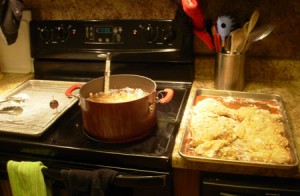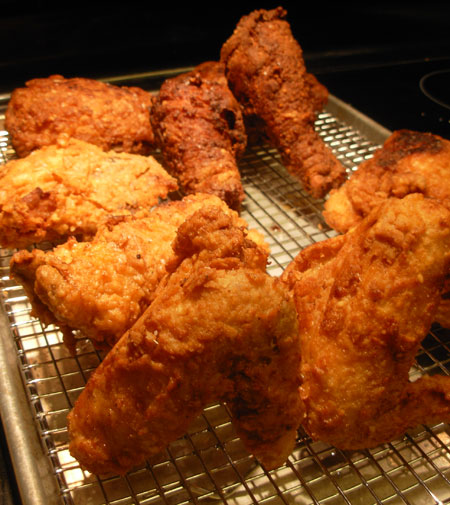Last night I finally made the dish I’ve been most looking forward to in the Thomas Keller Challenge. Not having grown up in the South, homemade fried chicken is something of a mystery to me. When I was little, without a mama’s or grandmama’s recipe to turn to, we ate a lot of Brown’s. (Their fried mushrooms are still awesome, BTW.)
And then it was the ’90s and fat was evil and we stopped eating fried chicken.
Now, I love good fried chicken, but it’s a rare treat for me. Well, the fried chicken at Ad Hoc is so beloved that Williams-Sonoma started selling a kit to make it; I had to try the stuff.
Keller’s recipe, as usual, isn’t simple, and it takes two days. You make a brine with lemon, honey, garlic, salt, and spices, cool it down, and then brine the chicken for 12 hours. (No more, no less, Chef Keller says.) Next, you take the chicken out of the fridge for an hour and a half to dry and come to room temperature before frying. Dredge in heavily seasoned flour, dip in buttermilk, coat in flour again, and you’re ready to cook (at very specific temperatures for each piece, of course).
Since my previous (and only) attempt at fried chicken managed to create legs that were both blackened outside and ice-cold raw within, I made sure to follow Chef’s directions to the letter this time. It paid off.
Brining makes the chicken juicy and sweet (there’s a lot of honey in there), and the frying technique leaves the chicken perfectly crisp and just the right brownness when it’s cooked through.
If you’re afraid of deep-frying, this is a good recipe to start with: Frying goes at an almost leisurely pace, with each part of the chicken getting its turn in the oil. Thighs first and legs next, both at 320°, then you raise the oil up to 340° and do the breasts and then the wings. It’s gonna take you 45 minutes or so to fry everything. That’s okay—you already devoted most of yesterday to this recipe.
I used to wing it with oil temperature, but I’ve become a firm believer in thermometers. You need a candy or fry thermometer for the oil and a meat thermometer to check doneness to pull this chicken off.
 Doing this assembly-line style makes things easier. My setup’s at left. I breaded all the pieces before I started anything else, put the oil in my largest, deepest pot (note the thermometer in there), and put a cooling rack over a baking sheet right next to the pot (note the other thermometer on there).
Doing this assembly-line style makes things easier. My setup’s at left. I breaded all the pieces before I started anything else, put the oil in my largest, deepest pot (note the thermometer in there), and put a cooling rack over a baking sheet right next to the pot (note the other thermometer on there).
You want to use a lot of oil; once it gets up to temperature it’ll stay there even when you drop in the chicken. This also makes fine adjustments easier—if it’s a bit too hot, turn the stove way down, and the oil will slowly cool rather than dropping all of a sudden. You can also reuse your frying oil. I let mine cool, then strained it through cheesecloth right back into the container it came from.
I also have to give a locavore shout-out to my chicken. I’m part of a co-op that picks up pasture-raised chickens from Goose Pond Farm in Hartselle, Ala., once a month. Their chickens have all been great, and huge. Last night’s was the smallest chicken I’ve gotten so far, and half of it fed five people. Gigantic chickens are usually tough or stringy, but that’s not the case with Goose Pond. (Or maybe is was Chef Keller’s brine. Who knows?)
If you’re ready to try it, here’s the recipe. Me? I’m off to grab a cold piece from the fridge.
